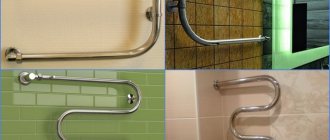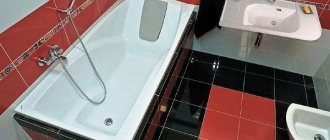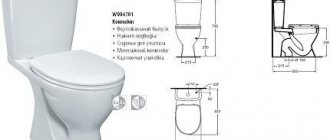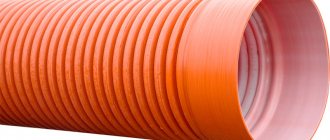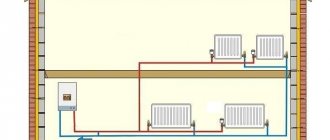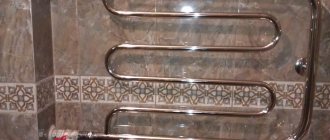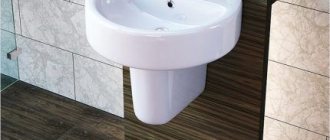Very often, even in a modern bathroom located in a multi-story building, there is no separate heat source, but in winter you want comfort and warmth. For this purpose, for many years, when constructing new buildings, metal coils have been installed in the bathrooms, which are connected to the central heating main and act as a towel dryer or an additional heater.
This device quickly gained popularity, since thanks to it, a comfortable warmth appears , which is so lacking during water procedures. By installing a heated towel rail, a person will not shiver from the cold when getting out of the bathroom. Plus, the coil can be used as an additional drying space for small laundry.
A classic heated towel rail is a pipe curved in a zigzag, on which you can hang wet towels without much difficulty. Naturally, progress does not stand still and every year new devices appear that operate not only from hot water, but also from electricity. At the same time, the sanitary products market offers a wide range of heated towel rails of various shapes and designs.
Functionality and purpose
Installing a heated towel rail in the bathroom is the key to comfort and coziness in the bathroom. Without such a device, it is difficult to heat the room for water procedures or dry towels. At the same time, modern products have the following functionality:
- heating the bathroom - the air in the bathroom quickly heats up, which allows even small children to comfortably take water procedures;
- in the bathroom there is often a very high level of moisture and therefore it is necessary to ensure high-quality and quick removal of condensation, which contributes to the development of mold and a heated towel rail is used for this;
- the ability, in addition to drying wet towels, to dry small laundry, which is especially important in the winter.
Very often natural ventilation in the bathroom is not enough to completely rid the room of excess moisture, and in such a situation, a well-chosen coil will become an indispensable assistant.
Design features of different coils
The modern plumbing industry does not stand still and every year new, more advanced and functional devices for heating the bathroom and drying wet towels appear. Therefore, before choosing the model you like, you need to understand how different heated towel rails differ according to their operating principle:
- water coil;
- electric heated towel rail;
- combined devices.
All models of heated towel rails presented may differ not only in shape, but also in cost. At the same time, it is impossible to say unambiguously which coil model is the best, since they all have both advantages and disadvantages. Therefore, before purchasing a suitable device, it is important to consider the different models separately.
Connection
What types of heated towel rails are there based on the connection type? The developers took into account all mounting schemes. The industry produces bathroom heated towel rails with five connection methods:
- to hot water supply,
- to the central heating system,
- to the power grid,
- for hidden power supply,
- for hidden heating system.
The direction of the connecting nodes is also taken into account, which can be:
- lateral (left or right),
- lower
Before purchasing and installing a coil in the bathroom, you need to choose:
- installation location,
- select a heating source.
Hot water coils
A heated towel rail running on a liquid coolant is considered a standard device used in any apartment. These are the devices that are in most of the bathrooms of our older relatives. This coil model fits into the central heating system and therefore starts working only during the heating season. A warm coolant circulates inside such a device, releasing its heat into the bathroom and drying wet towels.
When choosing a coil that runs on water, you need to be prepared for the fact that it will not always be warm . Throughout the entire period from spring to late autumn, such a product will be used as a clothes hanger. Although this problem does not concern the autonomous heating system, its use in the summer is impractical and unjustified in terms of financial costs.
Also, such a product is susceptible to the formation of air pockets or scale, which reduce the efficiency of its operation. Therefore, before installing such a coil, you need to think about the advisability of using it.
Installation steps
If the task is to replace an old device, then first you need to remove it, which is done very simply. The first step is to turn off the water and unscrew all the fastening nuts through which the device is connected to the water pipes. Then you should carefully remove the fasteners and device from the wall.
Once the dismantling work is completed, you can remove the new device from the box and begin installation. Holders are attached to the new model and connections are screwed through which water will be supplied. Next, the structure is placed against the wall, and the necessary marks are made with a pencil.
The next step is to drill all the holes in the tiles and insert dowels into them. It is better to use plastic products as fasteners. After making sure that the device is located correctly, all that remains is to fix it on the wall and connect it to the general piping system or central heating.
It is important to note that many bathroom coil manufacturers, as well as their distributors or retail outlets, offer a range of installation services. In this case, the task is performed by a specialist, and the consumer is provided with a full guarantee for installation work. When purchasing a new device, it is better to take advantage of this opportunity, as this will avoid many troubles in the future. But if independent installation does not seem incredibly difficult, then it is quite possible to implement it on your own.
Electric heated towel rail for the bathroom
A coil that uses electricity as an energy resource is an excellent alternative to an outdated water design. The main advantage of such a product is its autonomy , which means it can be used at any time of the year. The principle of its operation is based on the use of an electric heating element - a heating element, which heats the oil inside the device, maintaining a comfortable temperature.
Unlike a water-powered device, the electric analogue can be installed anywhere, regardless of the passage of heating pipes, as long as there is an outlet nearby. Moreover, due to the insignificant power of such a device, its operation does not greatly affect the total monthly consumption of electrical energy and therefore such a device can often be found in the hallway.
However, when giving preference to an electric coil for the bathroom, you need to pay special attention to the power of the device and the presence of a thermostat, which allows you to set the appropriate temperature parameters for the heater.
Many people wonder whether it is advisable to use an electrical appliance in a room with high levels of moisture. However, modern models are absolutely safe. Naturally, this does not mean that you can pour water on them.
Main types
Currently, various types of coils are offered in hardware stores. Among the most popular are:
- Water.
- Electric.
- Combined.
The last option combines the functions of the previous two, which makes it especially popular. But combined coils are not cheap.
Before deciding on a specific heated towel rail model, you need to make sure that it meets some requirements. It is also important to pay attention to a number of other points:
- When operating the device, the operating pressure must correspond to the pressure in the system. Any surges and deviations from the required norm can lead to damage to important components or the coil as a whole.
- It is also recommended to study the table that comes with the device and calculate the standard thermal power.
Combined coil designs
Such a universal device has absorbed all the positive characteristics of both water and electric coils. However, despite the functionality of such a product and the possibility of its use regardless of central heating, it has a rather high cost. Although such costs are justified , since there is no need to be afraid of interruptions in the supply of electricity or heat supply - in the absence of one of the coolants, there is always another heat source available.
Installation method
Depending on the mounting method, devices are divided into:
- wall,
- floor
Wall-mounted ones save space and fit well into the interior.
Floor-standing ones are large-sized samples. An unsuitable option for the bathroom of a typical apartment building. Before installing such equipment, you will have to re-equip the sewer system with replacement of water supply pipes.
Both wall and floor mounted ones can be equipped with a rotating mechanism. The essence of an interesting engineering solution is the ability to rotate part or the entire structure of heated towel rails.
Materials for making a coil
Regardless of the operating principle of different heated towel rails, the following common materials are used for their manufacture:
- The stainless steel variety is considered a practical choice for a heated towel rail in the bathroom. However, it must be taken into account that due to the aggressive composition and impurities in the coolant, they gradually destroy even such a durable material. Chrome-plated coils are considered the most reliable and visually attractive.
- Ordinary steel coated with a protective layer. A special feature of this heated towel rail is that the inside of the coil pipes is coated with a special anti-corrosion layer. At the same time, such a product is no different in appearance from its stainless steel counterpart.
- More expensive models of bath coils are made of copper or brass, which have a high degree of heat transfer. However, the cost of such products is very high. When buying such a device, you need to be extremely careful, since due to the high cost of the material used in its manufacture, you can often stumble upon a fake.
Regardless of what kind of coil you will purchase for a bathtub in an apartment or private house, it is better to give preference to well-known manufacturers who are concerned about their reputation and consumer safety.
Design features of modern coils
Modern heated towel rails have long evolved from a standard painted coil into an original design object . Such products have become so widely popular that when developing their appearance, famous designers are involved, who create original products, which are later replicated and put on store shelves. Such an original device not only copes with its direct responsibilities, but also decorates any bathroom.
On the plumbing equipment market, every homeowner will be able to choose a suitable product in a color that matches the overall design of the bathroom. This will complement the overall styling of the interior, making it complete and organic. By choosing products in bright colors, you can play on the contrast of the bathroom, emphasizing its individuality. If bright shades do not attract the homeowner, then you can always choose a chrome product that will succinctly fit into a room designed in a minimalist or high-tech style.
Form
The coil, familiar in the last century, has been replaced by various designs. Designers have developed many models, structurally based on six basic configurations. The passport indicates the shape of the product in the form of letters of the English alphabet.
U-shaped ones are considered simple in terms of connection. The model does not require additional system transformations and is easily connected to an existing highway. The only thing you need to pay attention to is the connection side. Both left-hand and right-hand instruments are available.
M – or as it is popularly called “snake”. Classic side connection option.
S is the same snake, only without a clear limitation on the contour and number of sections. While M-shaped ones cannot have more than four sections, S-shaped ones have 6-7 crossbars on some samples.
E - as a rule, these are three main crossbars attached to a single base rod.
I – available in two types. Horizontal and vertical. The presence of only one axis does not affect the quality of heat transfer in any way.
A ladder is a popular option on the market. The reason for its popularity is the location of a large number of drying panels and ease of installation. The form is present in all three types: electric, water, combined.
Non-standard - often manufactured according to individual orders. The group is represented by products of the company De Aqua, which specializes in the manufacture of non-standard furniture and equipment for bathrooms.
How not to make a mistake when buying a coil?
To make a rational choice when choosing a coil for your bathroom, you need to pay special attention to the following characteristics of the device:
- method of connecting the device - it is important to think in advance whether there are any interruptions in the power supply or heat supply in the apartment during the winter period;
- material used in the manufacture of the coil - you need to find out how resistant the product is to corrosion;
- heated towel rail parameters - the diameter of the coil inlet pipe must correspond to the dimensions of the heating system pipeline.
Having become familiar with the various parameters and characteristics of coils, every homeowner will be able to make the right choice of a high-quality and visually attractive heated towel rail for the bathroom. Thanks to this simple device, the bathroom will always be warm and dry .
Bathroom coils

